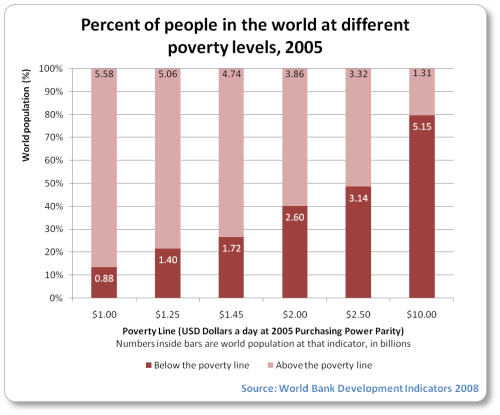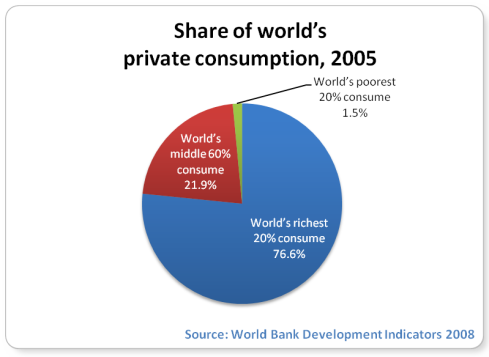Real versus Fake Marxism on Socialist Distribution
Prairie Fire
5 August 2009
LLCO.org
A global, socialist distribution of the world’s wealth implies a distribution that approaches egalitarianism or a distribution where the only inequalities that exist are ones that benefit the proletariat and most oppressed segments of the global population. These distribution principles, taken together, can be described as roughly, reasonably egalitarian vis a vis the current world economy. (1) The question that every serious Marxist must ask is whether people in the United States, and First World peoples generally, benefit or lose out under a socialist distribution of the world’s income. If the incomes of the First World working class, like the imperialist bourgeoisie, are so inflated that they need to be lowered under a socialist distribution, then there is no meaningful sense in which the First World working class is exploited. And, if, like the capitalists of the imperialist countries, the First World working class does not benefit under such a socialist distribution, then there is no reason to consider them part of the revolutionary subject, as part of the proletariat.

The majority of the world’s population live on under $ 2.50 (USD) a day. Over 80 percent of humanity, more than 5 billion, live on less than $ 10 (USD) per day. (2) The vast majority in the Third World live very differently than the working class of the First World. For example, the average working person in the United States has a white-collar job. He has an income of $ 32,000 (USD) or over $ 87 (USD) a day. (3) There are more people in India alone who make less than $ 0.80 (USD) a day than reside within the borders of the United States. (4) The working class of the First World often has more access to capital than the Third World capitalists, which explains how First World workers can obtain debt that is larger than the lifetime earnings of many Third World workers. This is because the ability to have large debt in the First World is a sign of wealth, of access to capital, not a sign of pauperization as it is in the Third World. Also, the average person in the United States lives in a house in a suburban setting, not in the destitute ghettos of megacities or in impoverished rural areas as Third World peoples often do. (5) The working class of the First World has much more in common with their own bourgeoisie, culturally and materially, than they do with the average Third World worker scraping by on survival wages. The latter, not the former, is who Marx described as the proletariat, as only having their labor to sell, as earning nothing but enough to eat and work the next day, of owning nothing, as having nothing to lose but her chains.

Virtually all First World peoples fall within the top 20 percent of global income. Most of the world’s richest 20 percent are First World peoples. Almost every person in the United States, for example, falls within the top 15 percent. A person in the United States at the so-called “poverty line” is at the richest 13 percent globally. (6) The top 20 percent, which includes the entire First World, accounts for three-quarters of world income. This leaves only one-quarter to be distributed to the bottom 80 percent in, mostly, the Third World. (7) The only way that the current income levels for First World peoples are maintained is through the imperialist exploitation of the Third World. The world economy is one that directs value flows from the Third World to the First World such that the First World as a whole benefits. The only way to maintain or expand current income levels in the First World is by maintaining these flows. This is going to be the case whether a regime in the First World calls itself socialist or not. In fact, many regimes, especially in Europe, have called themselves socialist or social democratic. None of these regimes sacrificed the income levels of their populations in order to redress Third World exploitation by the imperialists.
Three-quarters of the private consumption in the world is accounted for by the world’s richest 20 percent, mostly in the First World. Nearly all adult working in the United States fall within the richest 10 percent. (8) The richest 10 percent accounted for over half, 59 percent of the world’s private consumption. (9)

The current share of First World peoples is already much larger than what would be entailed by a rough egalitarian distribution. With the gap between the wealthy countries and the poor countries as large as it is, it is simply not realistically possible to increase the share of the First World working class without lowering the share of Third World peoples. Even if, by some miracle, the global pie was doubled and First World income and private consumption remained constant, the top 20 percent would still account for a disproportionate, nearly 40 percent, of the income and a disproportionate, nearly 40 percent, of the private consumption. In other words, it is not possible to even-out the situation between the top 20 percent and the rest of humanity even if the social product dedicated to consumption was doubled with all of the extra product going to the bottom 80 percent. It would take, roughly, a tripling of the pie under the current system to even things out.
First Worldist revisionists, like other imperialists generally, contend that First World peoples deserve more than their current share of the world’s resources. Even though overt white supremacy is now seen as uncouth, similar assumptions underlie all variants of First Worldism. First Worldists assume in a religious way that people in the United States, and First World peoples generally, should have more and that Third World peoples should have less. Because if one upholds the former, then one is committed to latter. To significantly raise the distribution in one part of the causal nexus of the world economy requires that the distribution be lowered elsewhere. It is simply impossible to maintain or significantly raise the standard of living for 300 million people in the United States without enforcing poverty elsewhere, in the Third World. Similarly, it is impossible to significantly increase the standard of living of roughly five billion people in the Third World without lowering the incomes of the remaining First World peoples. Failure to acknowledge this fact is pure utopianism, not Marxism. One cannot just wave a magic wand and raise everyone in the Third World to the First World, exploiter-level income and consumption levels. In fact, to universalize such levels is probably not even desirable or ecologically sustainable. Real socialists fight for a reasonable standard of living for all as part of ending all oppression. Socialists do not advocate a fantasy world where everyone lives as the wealthiest do. And, socialists do not advocate that current exploiter-level income and consumption levels be maintained, let alone increased, for the First World. After all, there is only so much productive capacity on the planet and only so many resources. This revisionist denial is where First Worldism meets the Theory of Productive Forces. First Worldists either have to reject the idea that socialism entails rough egalitarian distribution between peoples or they have to abandon their claim to be socialist. In either case, the First Worldist vision for society is one that seeks both to maintain and increase current global inequalities. First Worldism, whether it calls itself socialist or not, advocates inequality between peoples. It advocates imperialism.
It was Lenin who criticized the German and French social democrats when they supported the war efforts of their imperialist homelands in World War 1. The revisionists placed their own peoples, their own working class, ahead of the global proletariat by doing so. Lenin, by contrast, advocated the policy of revolutionary defeatism. Lenin sought the defeat of the Czarist empire in the hope that a defeat for his imperialist homeland could lead to a revolutionary situation. Contrary to Lenin, the revisionists of the Second International were the social imperialists and social fascists of their day. They were socialist in name, but in reality, they were imperialists. Today, First Worldism is the main form of social imperialism and social fascism. First Worldists may use Marxist and socialist rhetoric, but, in reality, they seek the advance the interests of their populations at the expense of the vast majority of humanity. Like Lenin before, Leading Light Communism represents the interests of the proletariat and oppressed as a whole. Just as Lenin made the break from the kind of narrow, unimaginative, dogmatic thinking of his day, so does every real revolutionary scientist, so too does Leading Light Communism. It is no surprise that our movement is universally condemned by the imperialists and social imperialists.
In Long Live the Victory of People’s War!, Lin Biao characterized the main social dynamic shaping our world as the global countryside confronting the global city. Thus the world revolution was conceived as a global people’s war where the revolutionary forces of the global countryside surrounded, cut-off, and crushed the global city. In this way, Lin Biao extended and universalized Mao’s theory of people’s war. Today, the characteristics of the global countryside and city are changing. For example, there has been a major demographic shifts within the global countryside. The peoples of the poor countries are not as rural as they once were. More and more are trapped, leading cruel, unproductive lives in the megacities of the Third World. In addition, the global countryside is more and more the site of capitalist production, not merely the site of backward, feudalistic agrarian production. Along with this, there is less and less production going on in the global city. Instead, the economies of the First World can be described as mall economies where people earn exploiter-level incomes employed in the areas of distribution, services, and management. The idea that the Third World lags behind the First World because they do not have technology within their borders is, more often than not, a First Worldist canard. The Third World is underdeveloped, it is configured to direct value flows to the First World. However, this is not the same thing as lacking the technology of production within its borders. Theorizing these changes within the context of the global people’s war is one of the main breakthroughs of the Leading Light Communist movement.
Notes
1. Even the latter distribution principle, which draws its inspiration from John Rawl’s Second Principle of Justice in A Theory of Justice, is still going to be vastly more egalitarian than the current world distribution or anything that First Worldists would propose.
2. http://www.globalissues.org/article/26/poverty-facts-and-stats
3. The Average Joe American, LLCO, July 2009 http://monkeysmashesheaven.wordpress.com/2009/07/24/the-average-joe-amerikan/
4. United States rich, India poor, so-called “international communism movement” deaf and dumb, LLCO, August 2007. Retrieved from: https://llco.org/united-states-rich-india-poor-so-called-international-communism-movement-deaf-and-dumb/
5. The Average Joe Amerikan, LLCO, July 2009. Retrieved from: https://llco.org/the-average-joe-american/
7. http://www.globalissues.org/article/26/poverty-facts-and-stats
9. http://www.globalissues.org/article/26/poverty-facts-and-stats

